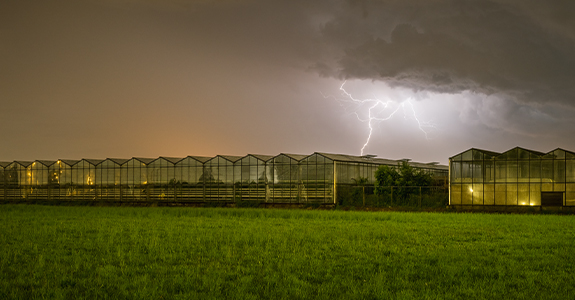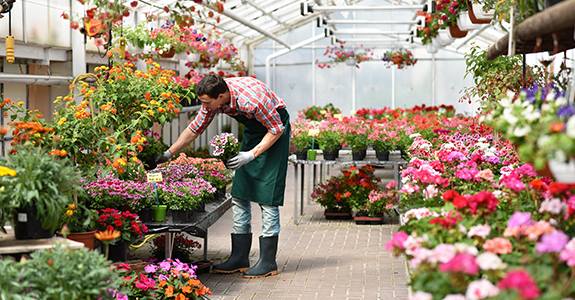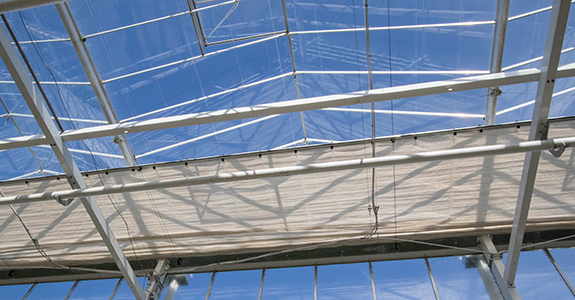Protecting your greenhouse in higher-risk areas: 6 risk management strategies

Greenhouses are vulnerable structures no matter where they’re located. But for operations in higher-risk regions—such as coastal zones, Tornado Alley, or areas prone to wildfires—additional protection is critical.
In 2024, the U.S. experienced 27 weather and climate events that individually resulted in more than a billion dollars in damage. Many of those events occurred in areas that are often considered higher-risk by insurance providers.
But weather isn't the only risk impacting greenhouses in these regions. Beyond the impact of extreme weather conditions, structural wear and a business’s financial preparedness also affect greenhouse longevity and operational resilience. Proactively addressing these risks can help you keep your greenhouse—and the employees who work in and around it—safe.
6 risk management strategies to help protect your greenhouse
Here are six best practices for greenhouses that operate in higher-risk locations.
Create an emergency preparedness plan
A well-designed preparedness plan can help you minimize damage from unexpected events. Develop a response plan for storms, floods, and other disasters. Train all staff members to be familiar with your procedures and their roles.
As part of that plan, instruct employees to secure loose materials and tools before severe weather strikes to help prevent additional damage. Keep stock of backup supplies, such as extra greenhouse cladding and support materials, allowing for quick repairs when needed.
Implement a preventive maintenance program
Routine maintenance is essential in helping prevent small issues from evolving into major structural failures. Make sure you:
Inspect greenhouse cladding regularly for damage and weaknesses.
Maintain all operational components, including fans, louvers, motors, blowers, and irrigation systems, to prolong efficiency and durability.
Watch for corrosion on the gutter posts (especially at the base), bracing, trusts, and areas where water pools, as this can lead to structural deterioration.
Conduct seasonal structural checks to help ensure that all joints, bolts, and fasteners remain secure, reducing the risk of unexpected failures.
Develop a safety plan for workers and equipment
Train your staff to follow emergency procedures and respond quickly to incidents.
Keep ventilation systems operating properly to maintain safe air quality.
Install essential fire safety equipment—such as extinguishers and smoke detectors—and test them on a regular schedule.
Maintain clear walkways throughout your greenhouse to help reduce trip-and-fall risks and allow for faster evacuation if needed.
Maintain a clean premises
A clean and organized greenhouse reduces the risk of pests and disease.
Remove debris and weeds regularly to help prevent infestations.
Frequently disinfect tools, tables, and other surfaces to limit the spread of pathogens.
Ensure proper drainage to avoid mold and water damage, which can weaken your greenhouse’s structural integrity over time.
Monitor your greenhouse covering for timely replacement
Greenhouse coverings deteriorate over time, reducing their effectiveness and increasing vulnerability to structure and crop damage. We recommend replacing standard plastic covers every four years. Polycarbonate covers can typically last 10–20 years, depending on exposures.
Signs of polycarbonate deterioration, such as significant yellowing, indicate that the material is weakening and becoming more susceptible to damage or breakage—especially wind and hail damage. Monitoring the condition of greenhouse coverings and following recommended replacement schedules can help you maintain a secure and efficient growing environment.
Be financially prepared
Having financial safeguards in place can help you stay afloat in the face of unexpected repairs. Adjusting your insurance deductibles can lower overall premium costs, while budgeting for scheduled material replacements can help prevent financial strain.
Insurance considerations
Your business insurance plays a crucial role in helping protect your greenhouse, providing financial security against unforeseen damage. Additionally, regularly reviewing coverages that can apply to weather-related damages is essential to ensure that policies cover specific perils.
Equipment breakdown coverage is particularly important, as it helps cover costs to get your essential systems, such as heating and ventilation, up and running again. This coverage can also serve as a safeguard for any crop spoilage due to a mechanical failure or an error like a system rebooting at the wrong time after a power outage.
Proactive protection
Protecting a greenhouse in a higher-risk area requires a proactive approach that includes structural reinforcement, regular maintenance, financial preparedness, and specialized insurance coverage.
By implementing risk management strategies, you can help safeguard your investments and ensure long-term sustainability.
If you’d like assistance in training resources, claims analyses, workshops, and on-site consultations to help identify and mitigate risks at your greenhouse, contact us. We’re here to help you and your business.

Safeguard Your Business From Severe Weather

Help protect your horticultural business with risk-relevant insurance coverage

Your greenhouse maintenance checklist
The information in this article is for informational or entertainment purposes only. View our disclaimer by going to terms and conditions and clicking on Learning Center disclaimer in the table of contents.



